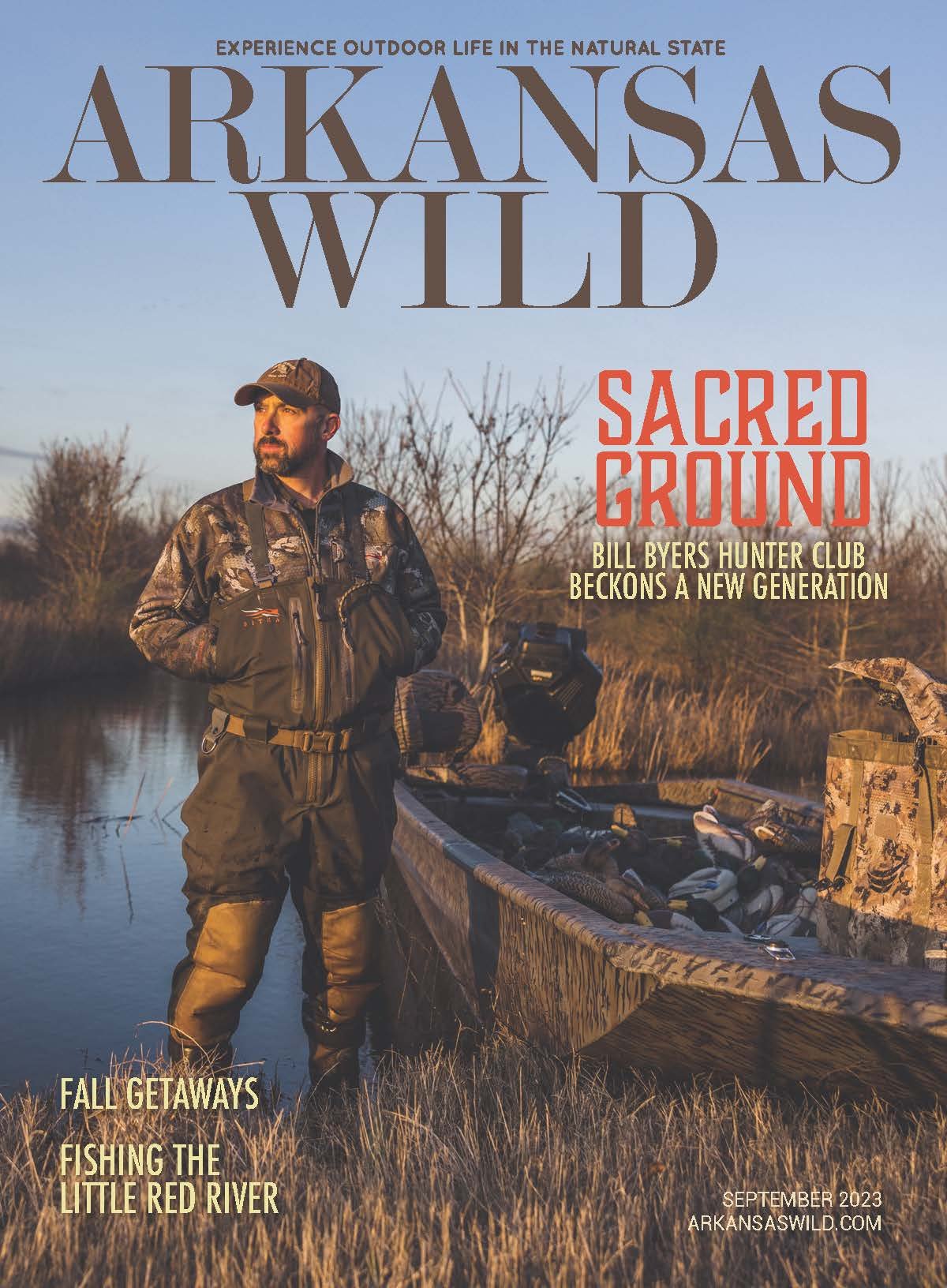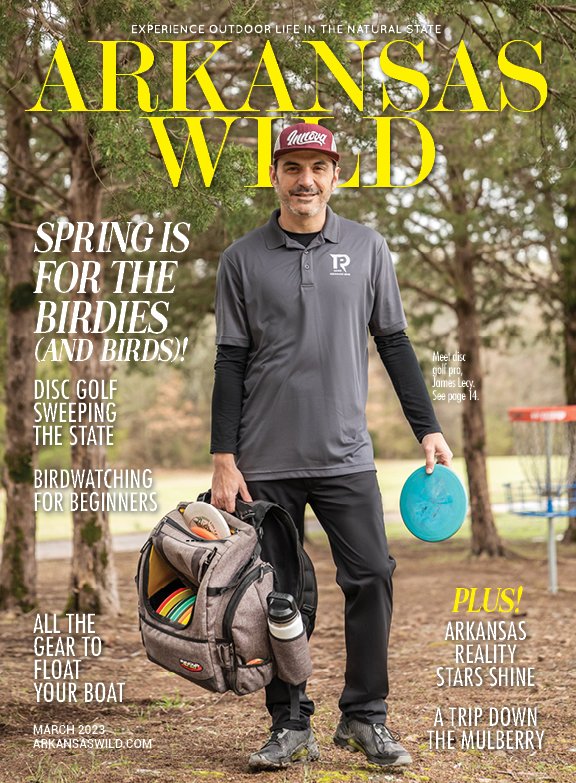The people you’ll meet on the following pages represent a wide range of experiences. One thing they all have in common, though, is a love for Arkansas and a commitment to the outdoors. Some of our Young Guns are new to the state, while others have lived here their entire lives. They build and maintain trails for hikers and bikers, operate businesses that make the Natural State accessible to hunters and fishermen—and they all have a goal of passing down what they’ve learned to their peers and to future generations. Meet Jarrod Norwood, Miguel Marquez, Tandie Bailey, Lindsey White, Nathan Woodruff and Eleanor Henry, the next generation of Arkansas outdoor legends.
By Michael Roberts
Photo by Rett Peek
Jarrod Norwood
"You’ll never feel more human than when you’re out enjoying your place in the world,” says Jarrod Norwood, founder of the innovative new hunting lease company Our Tracts. “We weren’t meant to sit at desks all day staring at computers. Lots of people want to hunt, but time and money are always issues.”
The Prescott native puts it into perspective like this: “If I join a traditional hunting lease, I get only a few days a year where I can hunt. It costs a lot of money, and I’m an hour or more away from home.” The solution? Day leases—though that didn’t come without hurdles.
The way the law works, giving someone permission to hunt doesn’t open a landowner up to any liability—unless there’s a fee associated. “You have to carry insurance—and most small land owners just don’t have the money or time to deal with that.” That’s where Our Tracts comes in.
With his company, Jarrod created a system where landowners can list their properties with his company, charge fees for use—and be covered by the Our Tracts insurance policy. “Landowners sign up with Our Tracts, specify the terms of use for their land, then we list their properties,” he says.
“We visit every piece of property before we list it,” Jarrod says. “We also conduct limited criminal background checks on everyone who wants to purchase a day lease—so we try to protect the landowners and our clients.”
For more information on Our Tracts, visit ourtracts.com.
Photo by Novo Studio
Miguel Marquez
"Growing up in Oakland, California, is the concrete jungle,” says Hot Springs National Park supervisory park ranger Miguel Marquez. “My parents would take us to the beaches or to see the redwoods—I developed a love of nature pretty early.”
He’s only been on the job in the Spa City for eight months, but he’s already implemented plans to increase access and awareness. “I’m in charge of educational programs, and I’m passionate about promoting our park to underserved communities,” says Miguel. “Hot Springs gets visitors from around the world, but I want to be sure that people just a few blocks away know what they have in their city.”
To that end, Miguel has been active on social media, posting pictures to Instagram and Facebook. He also is responsible for such programs as “Tea Time with a Ranger,” where park rangers hang out near the thermal water filling stations downtown with tea bags. “You don’t have to heat the water, of course,” he says with a laugh.
As Miguel settles into his position, look for more innovative ways to experience the park. “I want to take my GoPro and film a virtual tour of our trails to put online,” he says. During this centennial year for the National Park Service, it’s heartening to see the department in such capable hands.
For more information on Hot Springs National Park, visit nps.gov/hosp.
Photo by Novo Studio
Tandie Bailey
In many ways, enduro and downhill racer Tandie Bailey has grown up along with the Arkansas mountain biking scene. The Bentonville native first started riding at the age of 18, inspired by a brother who worked for the company who designed the Slaughter Pen Trail, Progressive Trail Design. “He and his friends would hang out at the dirt jumps,” Tandie says. “I wanted to be part of that.”
A member of Friends of Arkansas Singletrack (FAST) and Ozark Off Road Cyclists (OORC), Tandie has committed herself to both organizations’ mission of trail advocacy and maintenance. She also works with FAST’s mountain bike patrol, which offers first aid and bike maintenance to others out on the trails. After becoming certified by the International Mountain Bicycling Association (IMBA) as an instructor and ride guide, she began leading rides with a “no-boys-allowed, all-levels-welcome group” of women riders called the Dirt Divas.
“When I first started riding, the cycling community was tiny,” she says. “The past few years have seen an exponential growth in the community culture and style in our area.”
Tandie admits that mountain biking can be an intimidating sport to get into, but urges people to give the sport a chance. “Our riding community has proven that we’re there to support you,” she says. “We’re all in it together.” And for Tandie, more is always merrier.
For more information on FAST, visit fasttrails.org.
Photo by Novo Studio
Lindsey White
When a $3 million bank foreclosure forced Lindsey’s Resort in Heber Springs to close down in 2015, it seemed that Arkansas was faced with losing one of its classic fishing resorts for good. Lindsey’s began with the dream of Bill Lindsey, who purchased the land on the Little Red River for $12,000 back in 1965.
This is a story with a happy ending, though. By the beginning of 2016, the resort had been purchased and reopened by Brown Trout Incorporated. Even better, the new owners hired a familiar face to run the resort: Bill Lindsey’s grandson, Lindsey White.
Since the reopening, Lindsey has become something of a jack-of-all-trades at the resort. He’s earned a degree in hospitality, but years of working with his family have given him a skillset that few others could possibly possess. He’s overseeing an operation that boasts cabins renovated with wifi connections and new appliances, a fleet of fishing boats with brand new motors—and a couple of new party barges as well.
For Lindsey White, bringing a great experience to his guests is more than just a matter of running a successful business—it’s a way to keep his grandfather’s memory and legacy alive. From bait fishing to fly fishing, party barge fishing tours to self-guided boat and motor rentals, Lindsey White’s resort strives to offer the perfect fit for any fisherman.
For more information on Lindsey’s Resort, visit lindseysresort.com.
Photo by Novo Studio
Nathan Woodruff
When the International Mountain Bicycling Association (IMBA) comes to Bentonville for its 2016 World Summit, bikers from all over are guaranteed some of the best opportunities for cycling anywhere in the country. Arkansas has made a big leap in recent years in terms of bike trails, including five with an “IMBA Epic” designation—a number that ties the state for the second most in the country. One of the key people involved in this mountain biking renaissance is Nathan “Woody” Woodruff of Progressive Trail Design (PTD).
Woody’s company has designed trails across the country, from Detroit Lakes, Minnesota, to Aspen, Colorado, but it’s the PTD-designed Slaughter Pen Trail in Bentonville that folks in Arkansas know best. This trail is considered by many to be one of the catalysts for growth in Natural State mountain biking, turning the northwest corner of the state into an area that has become nationally renowned. For Woody, it’s part of giving back to a sport he’s loved for years.
Woody first got involved in mountain biking in the mid-1990s when he was in high school. Back then, mountain biking miles were hard to come by, but Woody nevertheless cut his teeth on trails like the Butterfield Trail, a rugged stretch with a trailhead in Devil’s Den State Park. That stretch of trail, coupled with a need for speed and adrenaline, has informed his trail designs to the present day.
For more information on Progressive Trail Design, visit progressivetraildesign.com.
Photo by Clay Newcomb
Eleanor Henry
"You want to know her secret? She just stays in the stand longer than anybody,” says Martin Henry of his daughter, Eleanor, who by age 17 had four record bucks listed by Boone & Crockett, the organization that keeps track of such things.
When we caught up with Eleanor, she was just finishing up her first set of mid-terms as a freshman at the University of Arkansas at Fayetteville. She recalled her most recent—and largest—record deer, killed when she was 17.
“It scored 208,” she says. “I killed my first record deer somewhere between age 12 and 14. That one was a 164.” In between, she added bucks that scored 176 and 184, all with her .243 rifle. “I hunt every weekend when I can. I get obsessed with it and I can’t quit,” she says.
Now that she’s in college studying marketing, she admits that she doesn’t have as much time for hunting as she once did. “I used to hunt every afternoon in high school—unless I had cheer practice,” she says with a laugh. “I’ll be able to hunt Thanksgiving, but my sister tells me she’s going to kill the big buck this year.” But she isn’t going to let life get in the way of her love of hunting.
“I will continue to hunt,” she says adamantly. “It’s an awesome thing. It’s something I will do with my family to pass along what I’ve learned from my dad.” Those big Delta bucks had better watch out.
For more information on big game records, visit boone-crockett.org.









